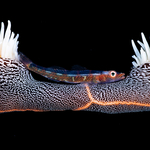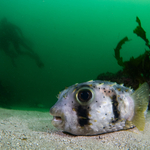Rebreathers for photography – the cons
By Nicolas and Lena Remy
If you have read my previous Wetpixel article, you know all the reasons why I switched to rebreathers 10 years ago and never looked back. I covered the advantages a rebreather brings for underwater photography when you have been properly trained, accumulated experience using it, and… when everything works well. Let’s now look at the other side of the coin.
Before I jump in, remember you must NOT dive a rebreather without proper training, and this article is not a course, rather a high-level overview of rebreather challenges, tailored to underwater image-makers. Talk with a rebreather instructor to get all details.
My wife Lena Remy diving a Poseidon Mark VI rebreather
First things first: what could possibly go wrong?
Compared to recreational SCUBA, rebreathers introduce 3 main risks:
* Hypoxia: each time you re-breathe the same gas, the partial pressure of oxygen (PO2) goes down. If it drops to 0.16 or below, you run a risk of passing out and drowning.
* Hyperoxia: This is well known to all Nitrox divers. If you breathe an oxygen-rich gas too deep, you risk convulsing and potentially drown. Most training agencies stipulate that the maximum acceptable partial pressure of O2 is 1.6 bar.
* Hypercapnia: When you breathe, the exhaled gas includes CO2, which can build up and various issues, including headaches, over-exertion, even passing out. This can happen in traditional diving when not ventilating properly, but the risk is higher when re-breathing the same gas.
Of course, all rebreathers have features to mitigate the above three risks, with various designs:
Hypoxia: an oxygen-rich gas is added, and for most rebreathers, this is done automatically.
Hyperoxia: the diver is alerted, typically with a Head-Up Display (HUD), a device that you have in sight.
Hypercapnia: one or two CO2 canisters, filled with sorb (CO2 absorbent), are responsible to filter out the CO2 from the exhaled gas.
Remark: Unlike Closed-Circuit Rebreathers (CCR), Semi-Closed Rebreathers (SCR) typically work on a single nitrox gas, which makes it easier to avoid hyperoxia, but doesn’t optimize decompression as much.
Problems arise when the equipment fails: just like your car may break despite being diligently serviced, the electronics that deal with hypoxia and hyperoxia may fail, and the sorb might be defective, failing to keep hypercapnia at bay.
It doesn’t have to be dramatic though, as a rebreather course trains you to detect these issues early and teaches you procedures to deal with every failure scenario and finish your dive safely.
Monitoring for issues, and be ready to deal with them
Electronics are involved in all rebreathers, and we know these don’t mix well with water, so a common saying goes; “don’t ask yourself if a rebreather failure will happen, ask when it will happen”.
I fully subscribe to this statement, which I’ll rephrase: “Be always prepared to deal with a rebreather failure”, and the key to this is frequent monitoring of your unit.
It’s like driving, you had to learn emergency braking, but you don’t know when you will need it, so you always stay attentive on the road.
The main thing you need to monitor is your partial pressure of oxygen (PO2), to ensure the gas you are breathing is safe (remember hyperoxia and hypercapnia), which is monitored by looking at your dive computer or your HUD (and by paying constant attention the volume of gas in the loop and any resulting buoyancy changes-editor).
You also need to be attentive to any sign of hypercapnia (sometimes headaches, heavy breathing), in the rare event that your canisters are failing to filter CO2 (mispacked, or exhausted sorb.
We know how busy and distracted an underwater photographer can be, but PO2 monitoring cannot be overlooked (pun intended).
To make my photographer’s life easier, I have chosen a dive computer that is mouthpiece mounted, meaning I can see not only my HUD light but also PO2 readings, without having to lift up my arm.
Always have safety in the back of your mind.
Dealing with a rebreather failure
Like I said earlier, every rebreather course teaches how to deal with equipment failure scenarios, but it’s a good thing to practice regularly, especially for failure scenarios that involve “bailing-out,” meaning: Closing the breathing loop, taking it out, and grabbing a standard 2nd stage regulator to breathe from, stabilizing yourself, and changing dive computer settings.
This isn’t a difficult procedure, provided you practice it on a regular basis, to be ready when you happen to need it.
It gets a bit trickier if you carry a large camera, two recommendations here:
Attach your housing to your harness with one or two expandable lanyards: this way you can safely drop your camera, and free both hands.
Use a Bail-Out Valve (BOV): this essentially makes it possible to switch to open-circuit bailout single-handed.
To put things into perspective, over 1300 hours diving 5 different rebreathers (cumulating my own dives and my wife’s), we have had to bailout 8 times. Four were equipment failures (e.g., dive computer flooded, mispacked CO2 absorbent), and four were user errors (e.g. jumping with too little gas and consume more than planned).
Lena finishes the dive on her 5.8l bailout tank. She had jumped with a partially empty 3l tank sufficient for 3+ hours of diving. However, we had unplanned ups & down following cheerful sea-lions, so she ended up quitting the rebreather loop, to avoid emptying the onboard 3l tank.
More time spent caring for your gear
Careful preparation, cleanup, and maintenance of your gear is how you minimize the chances of a rebreather failure, which adds up to the time you’re already spending on your camera & strobes.
Before diving, you need to fully assemble the rebreather, which includes filling and packing sorb into the CO2 canisters, attachment of the breathing loop components, testing for airtightness, controlling tanks, and electronics (batteries, O2 sensors), etc. It takes me 20-35 minutes to fully assemble my rEvo rebreather, depending on whether I have to change sorb, batteries, or swap 3-liter tanks.
It is best to do it in advance when you aren’t time-pressured so that you arrive for the dive fully ready. While OC divers will be assembling their tank/BCD/regs, your rebreather will already be good to go, save for a 1-5 minutes pre-dive check (depends on model).
After diving comes the time to fully rinse your rebreather inside out, pushing buttons and moving parts to avoid them getting stuck with drying salt (just like you do with your camera’s housing), but also rinsing the full breathing loop, while making sure NOT to soak the electronics, and then setting it to dry. The whole procedure takes me around 30 minutes, done carefully.
Lena rinsing the outside of our rEvo rebreathers, after a few great dives in Kas, Turkey.
Between consecutive dives, such as on a liveaboard or a multi-dives weekend, the whole maintenance can, fortunately, be shortened: you do not need to take your breathing loop apart each time, your CO2 scrubber may be good for several dives, etc. For example, on a double-tank boat dive, I will not open my rebreather between dives, and on a liveaboard trip, I will not disassemble the breathing loop for several days, and change sorb maximum once per day.
In any case, diving a rebreather involves spending more time caring for your dive gear, with the right level of concentration. As photographers, we have learned (sometimes the hard way), how important it is to be focused when caring for our camera gear, and the same applies to rebreathers.
On the positive side, rebreathers can easily be tested for leaks pre-dive, by pressuring the breathing loop, and waiting a few minutes for leaks. Such a test is part of every rebreathers’ assembly procedure, whereas only high-end camera housings offer such a safety feature.
The daily maintenance standing behind the author and a long-anticipated cold beverage.
Viewfinder access
It is worth knowing that a rebreather’s mouthpiece protrudes in front of your mouth and takes more space than a second-stage regulator (especially if you have a BOV). If you use your housing’s viewfinder to compose or review photos, know that you won’t get as close, and will struggle to see the full picture. This is easily mitigated by adding an external viewfinder, we use 45° viewfinders which have solved that problem.
Support in remote locations
Not all dive centers are equipped to cater for rebreather logistics, which revolve around three needs:
Pure O2 fills aren’t always available, but they are necessary to dive a closed circuit rebreather (CCR). A semi-closed rebreather (SCR) can run with nitrox fills though.
Specific tank sizes: most rebreather models require tanks in a specific size, such as 3 liter, which may not be available to rent.
Sorb availability: non-tech dive centers do not stock CO2 absorbent (but most will agree for you to ship it there or procure locally on your behalf).
Hence, unless your next dive trip is tailored to rebreathers, you need to enquire ahead of time to ensure these three needs can be met. If not, with a bit of advanced planning solutions can often be found: you could rent tanks elsewhere and bring them filled, or just travel with yours (empty if flying). For road-trips in Australia, we travel with four full 3-Liters oxygen tanks, each good for 6+ hours of CCR diving, in the 0-40 meters range.
In remote locations, sometimes these logistics are just not feasible, or too cost-prohibitive to put in place.
Bali in 2015, we stayed in a rebreather-friendly dive center north of the island, where we could rent 3l and bailout tanks, get pure oxygen fills, and sorb was readily available.
Re-learning buoyancy control and positioning constraints
Whilst rebreathers are more stable by design, this doesn’t come on day 1! Buoyancy control takes time to learn on a rebreather, just like it takes time on open circuit (OC). For an experienced OC diver, feeling like a beginner again can be frustrating! It took me 20-30 hours to feel comfortable enough to take a camera after I switched to CCR.
Another issue is the W.O.B (Work Of Breathing): OC equipment is comfortable to breathe in any position since the regulator constantly has 10 Bars pressure of gas to push in our mouth, all we need is to let it flow. On a rebreather though, breathing gas circulates only with the action of your lungs (pumping in/out). In standard diving position (nearly horizontal, torso slightly up) most rebreathers are very comfortable breathing. Getting head down/legs up to photograph that fish hidden between rocks… is another story. I simply don’t do this anymore.
Top-buoyancy control doesn’t come day 1, give yourself time to re-learn as you cannot use your lungs to stabilize yourself anymore.
Technology is no substitute for experience
Rebreathers are amazing pieces of technology, but there might be quick wins for your underwater photography, especially if you are a new diver. One is optimizing your weighting: anyone can go down comfortably with extra lead, but when over-weighted, you consume more air and stabilization is harder. Great buoyancy control is essential for photographers, improving opportunities whilst keeping the environment and yourself safe. Besides, when your rebreather fails, your backup solution is a traditional scuba tank, so best to be comfortable with it.
Now, if you have already optimized your weighting if your buoyancy is in control and if you know to avoid unnecessary movements when approaching subjects, then the next limiting factor is your open circuit gear, and rebreathers can widen your photographic horizons.
Is a rebreather the next step in your underwater imagery pursuit? Are you ready to see the other side?
Final considerations
In the previous article, you saw the advantages that a rebreather can bring, once you are certified and gained experience diving it. Only you can now decide:
Whether your photography is limited in ways that a rebreather can improve.
Whether those improvements are worth the trade-offs covered in this article.
If you are on the fence, why not book a try dive with your nearest rebreather instructor? I recommend trying at least two models, as different designs impact comfort and maintenance duration.
In any case, DO NOT attempt to dive a rebreather without getting certified on that model. It would be like riding a motorcycle on the highway without taking a rider license: you would be risking your life. On the other hand, don’t be intimidated by dramatic statements like “rebreathers are designed to kill you”: A motorcycle isn’t designed to kill you, but negligence and ignorance of safety procedures can have dramatic consequences.
Is rebreather diving a risky activity? Yes, but so is scuba diving! Before I took my open-water course in 2007, I was terrified of the idea of missing a safety stop and ending up paralyzed. Later I learned that, with training, staying stable at 5 meters was very easy, so long as I was responsible enough to monitor my SPG and ensure I had enough air for that safety stop. I was nervous when I got Nitrox certified in 2008: the PADI video of hyperoxia and the inevitable drowning haunted me until I decided that I was capable to reliably analyze my gas, mark my tank, update my dive computer and watch my depth. My CCR course in 2011 was a fair mix of excitement and fear. Yes, rebreathers introduce extra risks compared to single-tank SCUBA diving, but as I learned the procedures needed to mitigate those, I felt comfortable that I will be diligent enough to apply them while carrying a camera.
All-in-one don’t let others decide for you. Review these 2 articles, weigh the pros & cons, and speak with an instructor if you feel like exploring further. Over recent years, several manufacturers have released some rebreathers specifically aimed at recreational diving. These innovative units might not offer all the advantages of established rebreather models, nor be suited for deep/cave diving, but they are more affordable and their safety procedures are easier to learn and execute.
About the author
Nicolas REMY and Lena REMY are two awarded underwater photographers based in Sydney, Australia. Their work has been published in international media, where Nicolas writes about diving destinations, photographic equipment reviews and marine life behaviors. Nicolas teaches underwater photography in the form of group classes, workshops, and private on-demand coaching.
Visit their website to see more of their work or to get in touch.
Nicolas diving his rEvo rebreather. Photo courtesy of Thibault Serot.
Tagged: nicolas remy, rebrteathers
Read More Wetpixel.com




